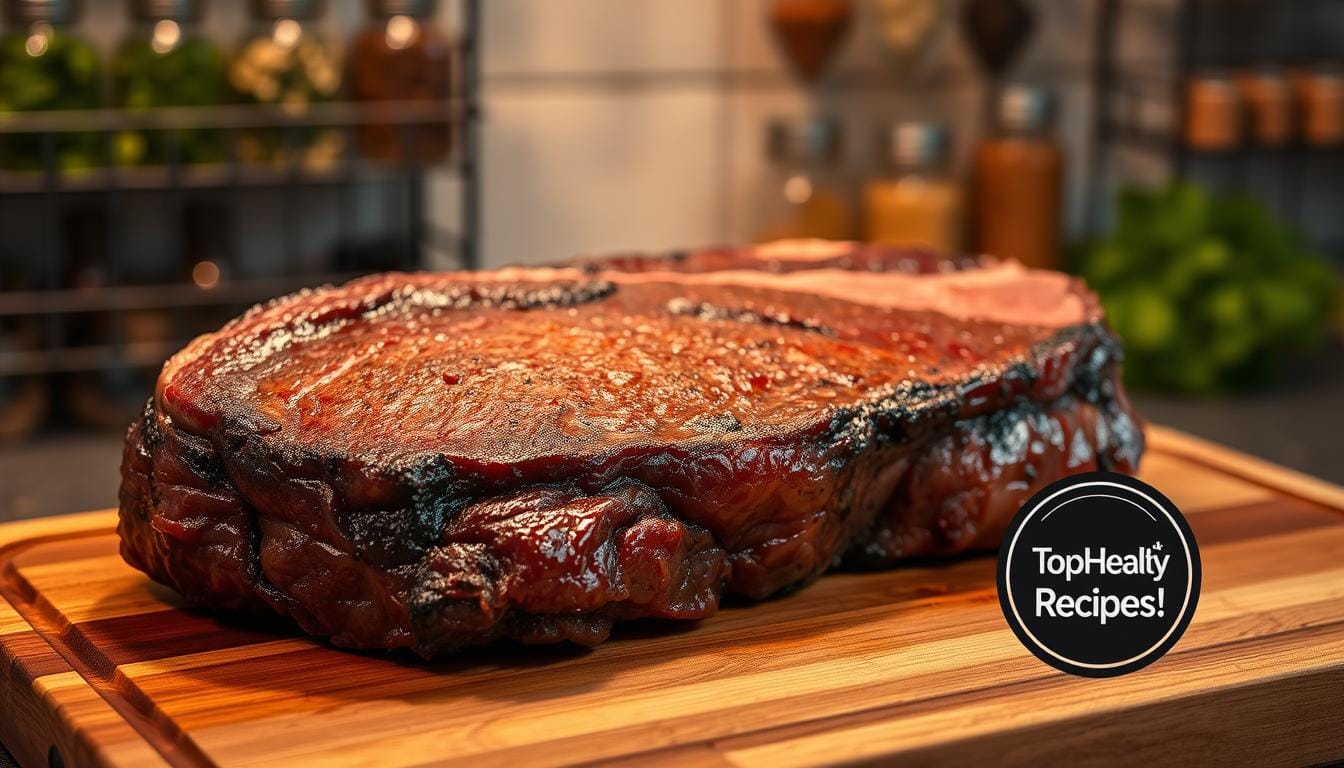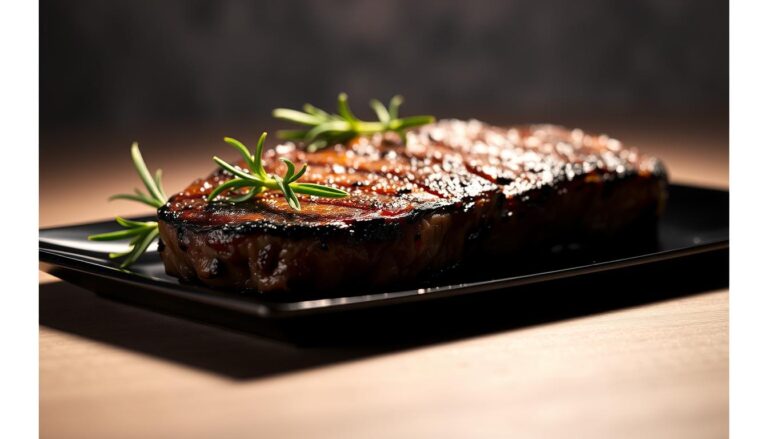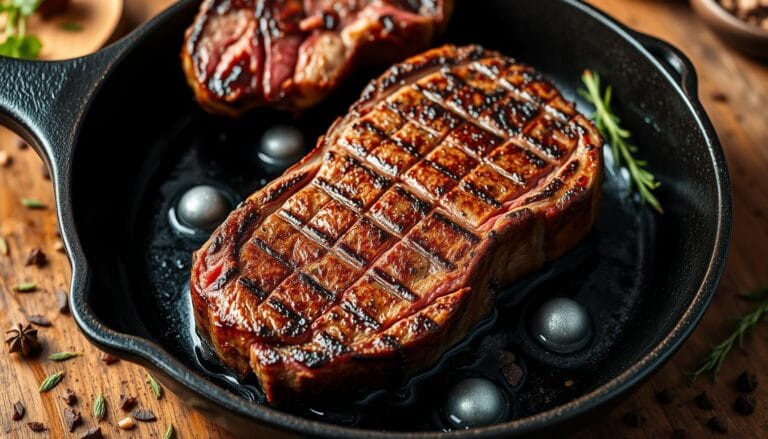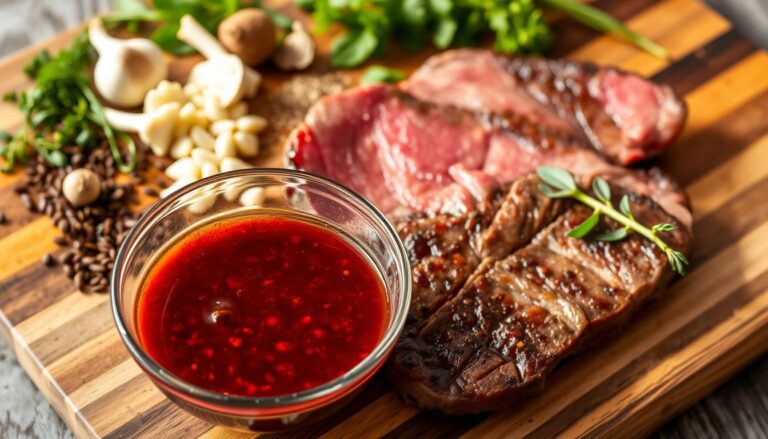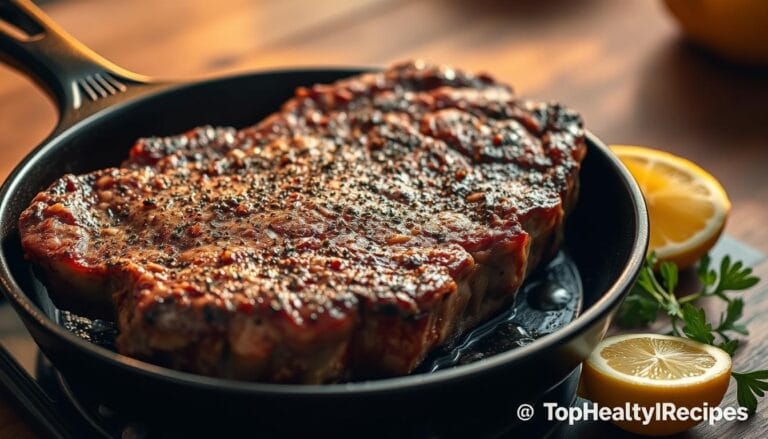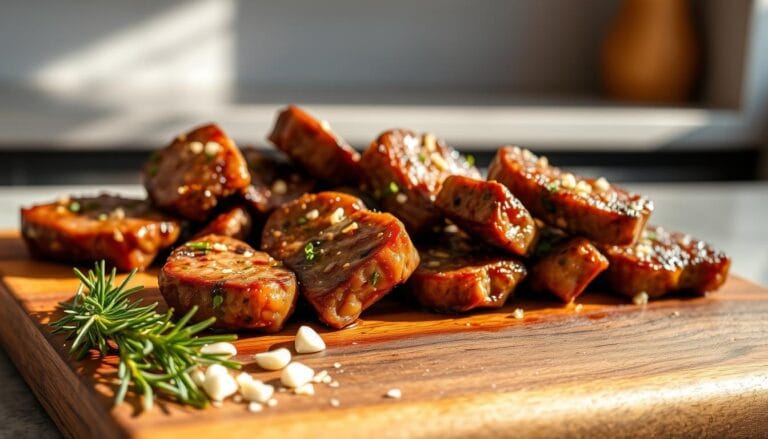Dry Age Steak in Fridge: Easy Tips to Do It Right and Safe
Table of Contents
Dry Age Steak in Fridge: Easy Tips to Do It Right and Safe
Imagine enjoying a perfectly aged steak at home. It’s tender and has a rich, intense flavor. Dry aging, once only for fancy steakhouses, is now easy to do at home.
This guide will help you dry age steaks in your fridge. You’ll learn the basics, how to pick the right cuts, and how to watch the aging process.
Follow this guide to make your steak taste like it’s from a top restaurant. It’s perfect for anyone who loves cooking or wants to try dry aging.
Key Takeaways
- Understand the basics of dry aging and its benefits
- Learn how to select the right steak cuts for dry aging
- Discover how to set up your refrigerator for dry aging
- Monitor the aging process for optimal results
- Cook your perfectly aged steak to perfection
What is Dry Aging Steak?
Dry aging steak is a method that lets natural enzymes break down the meat. This process makes the flavors stronger and the meat tender. When you dry age beef in your fridge, you start a controlled breakdown that improves the beef’s taste and texture.
Dry aging is different from wet aging, which happens in vacuum-sealed packages. Wet aging tenderizes the meat but doesn’t make the flavors as intense as dry aging. In dry aging, the meat loses moisture, which makes the flavors stronger and tenderizes the meat.
Key differences between dry and wet aging include:
| Characteristics | Dry Aging | Wet Aging |
|---|---|---|
| Flavor Concentration | High | Low |
| Tenderization | Yes, through enzymatic action | Yes, through enzymatic action |
| Moisture Loss | Significant | Minimal |
| Texture | Tender, with a crust | Tender, but no crust |
During dry aging, the steak gets a funky or nutty taste that steak lovers love. This taste comes from the meat’s natural flavors getting stronger and new compounds forming through chemical reactions.
Knowing how dry aging works helps you see why dry-aged steaks are more expensive. The better taste, tender texture, and hard work of dry aging make it worth more.
Benefits of Dry Aging Steak at Home
Dry aging steak in your fridge opens up a world of flavors. It’s not just about saving money on high-quality cuts. This section will show you how aging changes your beef and why it’s worth the effort.
Enhanced Flavor Profiles
Dry aging steak in your fridge leads to new flavors. The natural beef flavor gets stronger as moisture is lost. This creates a richer, nuttier taste that’s hard to find in fresh beef.
The aging process makes the steak more savory and aromatic. It breaks down proteins and fats, adding to the flavor.
Improved Tenderness
The aging process tenderizes the meat. Natural enzymes break down tough fibers, making the meat tender. This method is different from others and results in a buttery texture.
| Benefits | Description |
|---|---|
| Enhanced Flavor | Complex chemical reactions create new flavor compounds, resulting in a more robust taste profile. |
| Improved Tenderness | Natural enzymes break down tough muscle fibers, producing a buttery texture. |
| Customization | You can tailor the aging process to achieve your preferred flavor intensity. |
Choosing the Right Cut of Steak
The journey to a perfectly dry-aged steak starts with picking the right cut of meat. Not all cuts are the same when it comes to dry aging steak in the fridge.
To achieve the best results, choose large, bone-in cuts with good marbling. Ribeye, strip loin, and sirloin are great options. These cuts have more fat, which helps keep the steak moist and flavorful.
The protective fat cap on these cuts helps prevent too much moisture loss. This keeps your steak tender and full of flavor. Also, using high-quality meat is key for a great dry aged steak.
Steaks aren’t the best for aging. Use subprimal cuts instead for better results. These cuts are larger and have fat and meat evenly distributed. Buying quality beef from local butchers or online will help you start right, allowing you to age meat fridge techniques well.
By picking the right cut and quality of steak, you’re on your way to enjoying a perfectly dry-aged steak at home.
Equipment Needed for Dry Aging
To dry age steak at home, you need the right tools. The right equipment helps create the perfect environment for your meat.
Selecting Your Refrigerator
Choosing the right fridge is key for dry aging. Your fridge should control temperature well and have good airflow. A standard fridge might work, but check if it can keep a steady temperature between 34-38°F.
Also, think about fridge space. You’ll need a special area for aging meat. And, to avoid smells, using a separate mini-fridge is a good idea.
| Refrigerator Feature | Ideal Specification | Importance Level |
|---|---|---|
| Temperature Control | Consistent temperature between 34-38°F | High |
| Airflow | Good airflow around the meat | High |
| Auto-Defrost Cycle | Avoid refrigerators with auto-defrost | High |
| Space | Dedicated space for dry aging | Medium |
Using Dry Age Bags
Dry age bags make home aging easier. They protect meat from moisture loss and contamination. These bags have a special membrane that lets moisture out but keeps contaminants in.
To use them well, follow the maker’s guide for sealing. This method is loved for its success and simplicity.
Other options include cheesecloth wrapping and special containers. But, dry age bags offer better protection.
Preparing Your Steak for Dry Aging
Before starting the dry aging process, it’s key to prepare your steak right. This ensures the best results. You need to follow a few steps to make sure your steak ages well and tastes great.
Trimming the Steak
Trimming is often needed before aging starts. It’s important to know what to leave and what to remove. The fat layer should stay to protect the meat, but any silver skin or unwanted parts should go.
To trim well, you’ll need sharp tools. A sharp knife is best for clean cuts. Keeping the meat clean is also important to avoid contamination. The amount of trimming needed depends on the steak type.
- Remove any silver skin or connective tissue that could interfere with the aging process.
- Leave the fat cap intact to protect the meat.
- Use a sharp knife to make clean cuts.
Seasoning Options
Traditional dry aging doesn’t use seasonings, but there are other ways to flavor your steak. Some age unseasoned beef to let its natural flavors shine. Others try herb crusts or rubs for unique tastes.
Choosing seasonings can change your steak’s taste and aging process. You can stick to traditional methods or try new flavors during aging.
Key considerations for seasoning:
- Understand that additional seasonings can alter the flavor profile of your steak.
- Be aware that some seasonings might affect the aging process.
- Consider the type of steak you’re aging and how it might benefit from additional flavors.
By trimming and choosing your seasonings wisely, you’re on your way to a delicious dry-aged steak at home.
Ideal Temperature and Humidity for Aging
Dry aging steak needs careful control of temperature and humidity. This ensures quality and safety. The right environment is key for the steak’s flavor and tenderness.
Your fridge should be between 34-38°F (1-3°C). This range slows down bacteria and breaks down proteins and fats. Small temperature changes can harm the aging process.
Humidity should be between 75-85%. This balance prevents the steak from drying out or getting too wet. Use humidity gauges and methods like salt blocks or water containers to adjust.
Regularly check temperature and humidity. Affordable gauges help keep your fridge perfect for dry aging. This control improves your steak’s quality and safety.
Getting the right conditions might take some work. But the effort is worth it. With the correct temperature and humidity, your steak will taste better and be more tender.
Duration of Dry Aging
The time you dry age beef in the fridge affects its taste and texture. The length of time depends on what you like and what you want to achieve.
Dry aging can be broken down into three main periods: short, medium, and long. Knowing these helps you dry age beef in the fridge well.
Short-Term vs. Long-Term Aging
Short-term aging lasts from 14 to 21 days. It’s great for beginners because it makes the steak tender with a hint of flavor. It’s a good start for those new to dry aging.
Medium-term aging goes from 21 to 35 days. It brings out more flavor while keeping the beef taste familiar. It’s a balance of tenderness, flavor, and safety.
Long-term aging (35+ days) changes the beef the most. It has strong flavors that some love and others find too strong. It’s important to think about the risks and rewards of longer aging.
To find your perfect spot, think about what you like and how much risk you’re willing to take. If you want a stronger flavor, go for longer aging. For a milder taste, choose shorter aging.
Knowing how different aging times affect your steak helps you make better choices. This way, you can get the quality of steak you want from your fridge.
Monitoring the Aging Process
Successful dry aging requires careful monitoring. As your steak ages, it will look different. Knowing these changes is key to getting the best results.
Visual Indicators of Progress
The steak’s outside will change a lot during dry aging. You’ll see a pellicle, a dry crust, form. This crust makes the steak taste better and gets it tender. The steak might also get darker, which is a good sign.
It’s important to tell normal changes from bad signs like mold. Good mold is white and powdery. Bad mold is green, black, or slimy. Check your steak often to spot any problems early.
- Check for the development of the pellicle
- Monitor the color of the exterior
- Look for signs of mold or slime
Maintaining Temperature Consistency
Keeping the temperature steady is vital for safe and quality dry-aged steak. Avoid opening the fridge too much and keep it tidy. This helps the steak age well. Use a thermometer to check the fridge’s temperature.
Here are some tips for a stable aging environment:
- Limit the frequency of opening the refrigerator door
- Keep the refrigerator well-organized to ensure good air circulation
- Use a thermometer to monitor temperature fluctuations
Safety Considerations
To enjoy dry aged steak safely, it’s important to know the safety tips. Dry aging stops many harmful bacteria, but some risks stay. You need to understand the microbiology of dry aging.
The drying surface and cool temperatures stop bad bacteria. They also let good enzymes work. The pellicle, or dried outer layer, is key to keeping meat safe. It stops bad bacteria from getting inside.
Bacterial Growth Risks
The pellicle acts as a shield, keeping the meat safe. But, it’s important to handle and watch the meat closely. Proper handling and monitoring are essential to prevent bacterial contamination.
It’s important to tell the difference between harmless surface molds and dangerous bacterial contamination. Regular inspection and keeping the right temperature and humidity levels are key to preventing contamination.
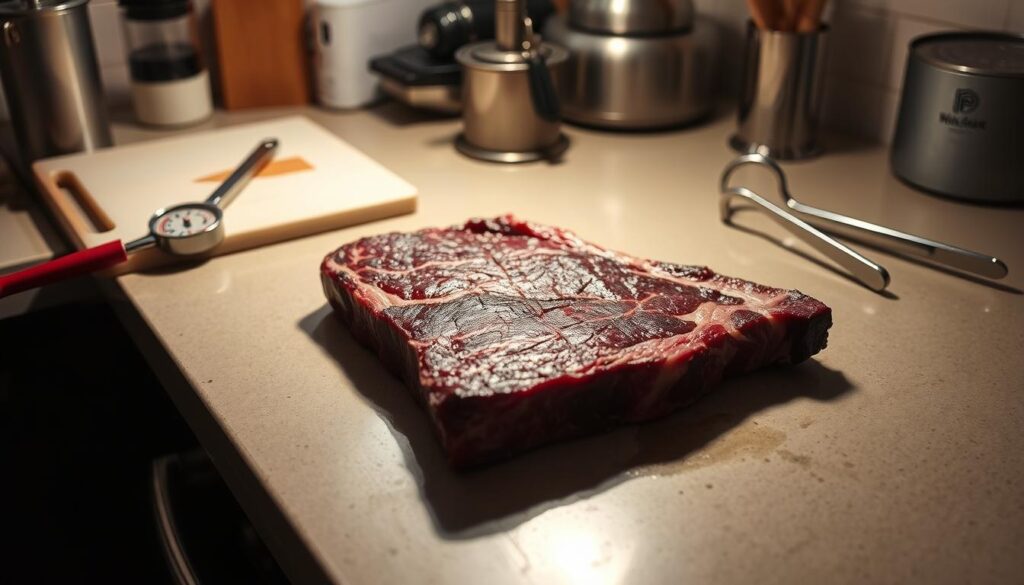
Proper Handling Techniques
Keeping contamination low is key for safe dry aging. Follow best practices like washing hands, cleaning tools, and keeping the workspace clean. When handling the meat, try not to touch it too much to avoid bringing in bad bacteria. Use clean utensils and gloves when rotating or adjusting the meat.
- Inspect the meat regularly for signs of spoilage or contamination.
- Rotate the meat with minimal handling to ensure even aging.
- Sanitize your tools and workspace before and after handling the meat.
By following these tips, you can keep your dry aging safe. Proper handling and watching will let you enjoy your dry aged steak safely.
How to Store Dry Aged Steak
Storing dry aged steak needs careful thought to enjoy it fully. After aging your steak perfectly, you must handle it right to keep its flavor and tenderness.
The first step is to trim the dried exterior, or pellicle, that forms during aging. This step is key as it makes the steak look better and taste even better.
After trimming, cut the steak into portions for easy serving. For short-term storage, vacuum sealing helps keep moisture in and flavor strong. If you won’t eat it right away, freezing is a good choice for longer storage.
When storing dry aged steak, keep the fridge or freezer at a steady temperature. This stops bacteria from growing. It keeps your steak safe and of high quality.
Slicing and Cooking Dry Aged Steak
The moment of truth arrives when you slice and cook your dry aged steak. It needs techniques that complement its developed flavor and texture. After weeks of aging, proper preparation and cooking are key to show off the enhanced flavors and texture.
When cooking dry aged steak, the right methods are key. High-heat cooking techniques like cast iron searing, grilling, or broiling are best. They create a flavorful crust while keeping the inside juicy. This is because dry aged steaks have less moisture, cooking faster than fresh steaks.
Recommended Cooking Methods
To bring out the best in your dry aged steak, understand its unique cooking needs. Due to less moisture, dry aged steaks cook faster. It’s important to watch the temperature closely to avoid overcooking.
- Use a thermometer to ensure accurate internal temperatures.
- Cast iron searing or grilling can achieve a perfect crust.
- Broiling is another effective method for cooking dry aged steak.
For the best results, keep seasonings simple. This lets the complex flavor of the dry aged beef shine. A light seasoning can enhance the natural flavors without overpowering them.
Pairing Suggestions
The unique flavor of dry aged beef pairs well with certain foods and drinks. Classic steakhouse sides like garlic mashed potatoes or grilled asparagus add texture and flavor. For wine and spirits, a rich red wine or smooth whiskey complements the beef’s flavor.
Simple sauces like béarnaise or peppercorn sauce can also enhance the meal. The robust, nutty qualities of aged beef offer pairing possibilities that fresh steaks can’t match. This helps create a complete dining experience that showcases your culinary skill.
Frequently Asked Questions about Dry Aging
Dry aging steak at home can raise several questions. These include safety concerns and the quality of the final product. Here, we address some of the most common queries to help you navigate the dry aging process with confidence.
One of the first questions many have is whether they can use their regular refrigerator for aging meat. The answer is yes, you can dry age steaks in your fridge, provided you maintain the right conditions. Ensure your refrigerator is set at a consistent temperature below 39°F (4°C). Consider using a dry age bag to control humidity and prevent contamination.
Safety is a top concern when dry aging. To minimize risks, always handle your steaks with clean utensils. Make sure your refrigerator is at the correct temperature. Beneficial molds will typically appear as a white or light gray coating on the surface of the steak. Harmful molds are usually green, black, or have a slimy texture. If you’re unsure, it’s best to err on the side of caution and discard the steak.
Many wonder if they can dry age individual steaks. While it’s more challenging due to the higher surface-to-volume ratio, it’s possible with the right equipment, such as a dry age bag. These bags allow for air circulation around the steak while keeping contaminants out.
Weight loss is another consideration. During the dry aging process, steaks can lose a significant amount of weight due to moisture loss. The exact percentage can vary, but a loss of 20-30% is not uncommon over a couple of weeks.
You might also be curious if you can apply this process to other meats. While beef is the most commonly dry-aged meat, you can also dry age other meats like venison or lamb. Provided you follow similar safety guidelines and monitor the aging process closely.
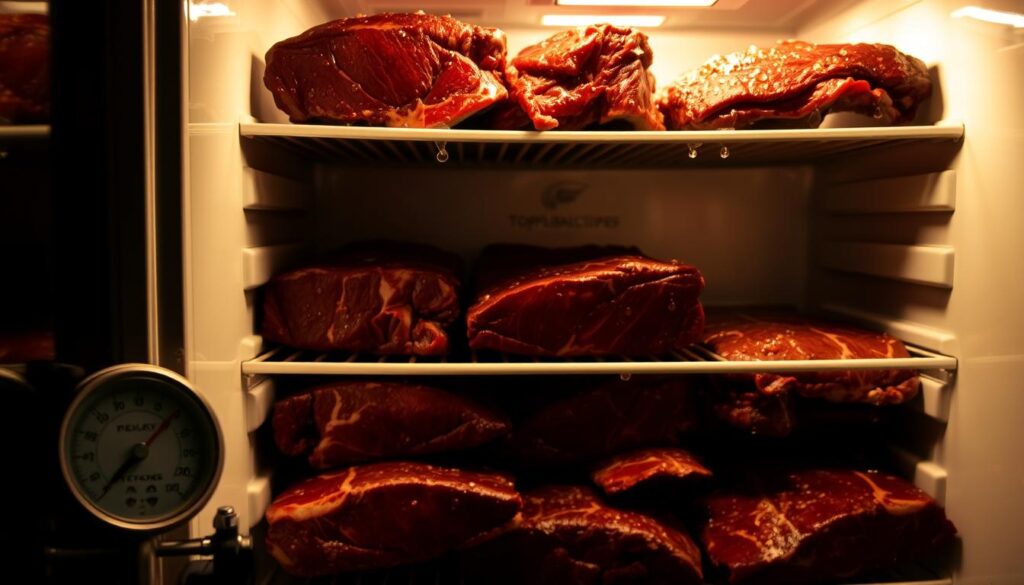
By understanding these aspects of dry aging, you’ll be better equipped to produce high-quality steaks. These steaks will be both safe to eat and full of flavor. Whether you’re a seasoned chef or a curious home cook, dry aging can elevate your culinary experiences.
Conclusion: Enjoying Your Dry Aged Steak Experience
Now you know how to dry age steak in your fridge. By choosing the right cut and keeping the right conditions, you can enjoy amazing steak. Dry aging at home means you get top-quality beef without the high price.
Start with short aging times to get used to it. Then, try longer times to find what you like best. With patience and care, you’ll make your steak taste amazing. It will be tender and full of flavor, making your meals special.
Learning to dry age steak improves your cooking skills. It also helps you understand meat better. So, begin dry aging your steak today. Enjoy the delicious results of this fun cooking project.
FAQ
Can I dry age steak in my regular refrigerator?
How long can I dry age steak?
What type of steak is best for dry aging?
How do I maintain the right humidity level in my refrigerator?
Can I dry age individual steaks?
How much weight loss can I expect during dry aging?
Can I dry age other meats beside beef?
How do I know if my dry aged steak has gone bad?
How should I store dry aged steak after the aging process?
Can I freeze dry aged steak?
For more cooking tips, stay connected with us. We also recommend the cookbook Skinnytaste Simple: Easy, Healthy Recipes with 7 Ingredients or Fewer
For more Recipes about Beef?
Did You try our recipe ?
There are no reviews yet. Be the first one to write one.
